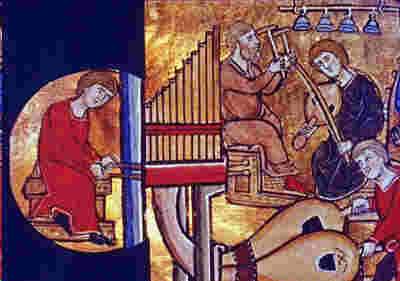

|
| |||||||||||||||||||||||||||||||||||||||||||||||||||||
|
|||||||||||||||||||||||||||||||||||||||||||||||||||||
|
| |||||||||||||||||||||||||||||||||||||||||||||||||||||

shared musical treasuresHere The Muse of Music invites you to explore the world of Shared Musical Treasures.
about this featureMany musical themes and pieces are identified with, adopted by, or adapted by, more than one nation, culture, society, or age. Many are incorporated in more than one work by a given composer or appear in works by many composers. The Muse of Music has dubbed musical themes and works that fit this description, Shared Musical Treasures. What accounts for the popularity and spread of a shared musical treasure? Sometimes accidental circumstances compel the attention of people from a variety of different ethnic, religious, or cultural backgrounds. Coincidental circumstances may conspire to make a tune or musical idea universally popular. At other times, some quality in the music seems to be so fundamental to human nature or to the human condition that it strikes a common chord. Examples of shared musical treasures:
Other examples: Bob Dylan's Blowing in the Wind, We Shall Overcome, Amazing Grace, Battle Hymn of the Republic, God Save the Queen, Thoughts Are Free (from the Peasant Rebellion of the Reformation), Paganini's 24th Caprice, themes from Bizet's Carmen, and themes from Mozart's Marriage of Figaro, to name a few. Here The Muse of Music identifies such musical phenomena and explores the circumstances surrounding them. explore these shared musical treasuresThe Muse of Music examines each shared musical treasure on its own page at Electricka's web site. Scan the list of shared treasures, below, and click the one you want to visit.
Dies IraeDies Irae is the name of a devoutly religious thirteenth century Latin hymn that was originally sung only by and for monks. Its subject is the end of the world, God's wrath on the Last Day, the Day of Judgment. The importance of this theme {Ref.} in secular (classical) music cannot be overstated. This melody has often been incorporated in programmatic {Ref.} compositions having death or damnation as their subject, and the appearance of this theme in a musical performance has frequently functioned as a motif or a "tip off" about what the composer is saying, about what is happening in the music at the time the theme is heard, or about what the composer would have us think or feel. Indeed, the Dies Irae is so prevalent in music and so firmly implanted in the consciousness of literate music lovers everywhere, it qualifies both as an outstanding example of Ancient Music and as an outstanding example of a shared musical treasure.
ETAF RecommendsAll of the themes and pieces cited in Shared Musical Treasures are represented in the ETAF-Amazon Collection. See the page dedicated to a specific shared treasure for suggestions on materials about that treasure that you can explore or acquire.
Search this web site with Electricka's Search Tool:
tap or click here
Electricka's Theme Products
Shop At Cafe Press
This web site and
its contents are copyrighted by
Decision Consulting Incorporated (DCI).
All rights reserved. |
| ||||||||||||||||||||||||||||||||||||||||||||||||||||